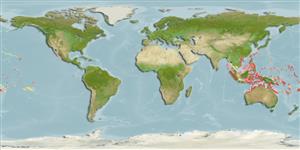分类 / Names
俗名 | 同种异名 | Catalog of Fishes(属, 种) | ITIS | CoL | WoRMS | Cloffa
Teleostei >
Blenniiformes (Blennies)
鱸形目 (Blennies) >
Blenniidae (Combtooth blennies) > Blenniinae
Etymology: Meiacanthus: Greek, meion = less = lessen + Greek, akantha = thorn (Ref. 45335).
Environment: milieu / climate zone / depth range / distribution range
生态学
海洋 礁区鱼类; 深度上下限 0 - 18 m (Ref. 58018). 熱帶; 30°N - 22°S
Western Pacific: Moluccas and the Philippines east to Samoa, north to Ryukyu Islands, south to Rowley Shoals in Western Australia and the northern Great Barrier Reef and Tonga; Palau (Belau) in Micronesia.
西太平洋: 模里西斯與菲律賓東至美屬薩摩亞, 北至琉球群島, 南至羅雷游入西澳大利亞與大堡礁北方與東加; 在密克羅尼西亞的帛琉 (帛琉)。
大小 / 重量 / 年龄
Maturity: Lm ? range ? - ? cm
Max length : 6.5 cm TL 雄鱼/尚未辨别雌雄; (Ref. 90102)
背棘 (总数): 5 - 6; 背的软条 (总数): 225; 臀棘 2; 臀鳍软条: 15 - 18. Males with long filaments from the tips of the tail (Ref. 48636).
雄性有来自尾巴的尖端的长的丝状突起。 (参考文献 48636)
Adults are found on reef slopes with large soft-coral communities (Ref. 48636). They form groups usually among gorgonians or black coral (Ref. 90102) in shallow protected reefs. Relatively common and broadly distributed. Feed on zooplankton. Oviparous. Eggs are demersal and adhesive (Ref. 205), and are attached to the substrate via a filamentous, adhesive pad or pedestal (Ref. 94114). Larvae are planktonic, often found in shallow, coastal waters (Ref. 94114). Minimum depth from Ref. 58018.
在礁斜坡上有大的软珊瑚群落。 (参考文献 48636) 相当普遍的而且宽广地分布了。 在水浅且有遮蔽礁区中形成鱼群并且吃浮游动物。 卵生的.(参考文献 205) 卵是底栖与聚集在一起的。 (参考文献 205)
Life cycle and mating behavior
成熟度 | 繁殖 | 产卵场 | 卵 | 孕卵数 | 仔鱼
Oviparous, distinct pairing (Ref. 205).西太平洋: 模里西斯與菲律賓東至美屬薩摩亞, 北至琉球群島, 南至羅雷游入西澳大利亞與大堡礁北方與東加; 在密克羅尼西亞的帛琉 (帛琉)。
Myers, R.F., 1991. Micronesian reef fishes. Second Ed. Coral Graphics, Barrigada, Guam. 298 p. (Ref. 1602)
人类利用
更多信息
参考文献养殖养殖信息品种遗传学Electrophoreses遗传率疾病加工NutrientsMass conversion
合作者照片Stamps, Coins Misc.声音神经毒速度泳型鳃区Otoliths脑重体重比眼睛色素
工具
特别资料
下载 XML
网络资源
Estimates based on models
Preferred temperature (Ref.
123201): 25.7 - 29.3, mean 28.5 °C (based on 1738 cells).
Phylogenetic diversity index (Ref.
82804): PD
50 = 0.5000 [Uniqueness, from 0.5 = low to 2.0 = high].
Bayesian length-weight: a=0.00562 (0.00258 - 0.01228), b=3.06 (2.87 - 3.25), in cm total length, based on LWR estimates for this (Sub)family-body shape (Ref.
93245).
营养阶层 (Ref.
69278): 3.4 ±0.45 se; based on food items.
回复力 (Ref.
120179): 高度, 族群倍增时间少于 15个月 (Preliminary K or Fecundity.).
Fishing Vulnerability (Ref.
59153): Low vulnerability (10 of 100).
Nutrients (Ref.
124155): Calcium = 196 [100, 373] mg/100g; Iron = 1.06 [0.61, 1.83] mg/100g; Protein = 18.2 [17.0, 19.3] %; Omega3 = 0.104 [0.054, 0.196] g/100g; Selenium = 21.9 [10.2, 50.3] μg/100g; VitaminA = 226 [75, 707] μg/100g; Zinc = 2.15 [1.38, 3.19] mg/100g (wet weight);
